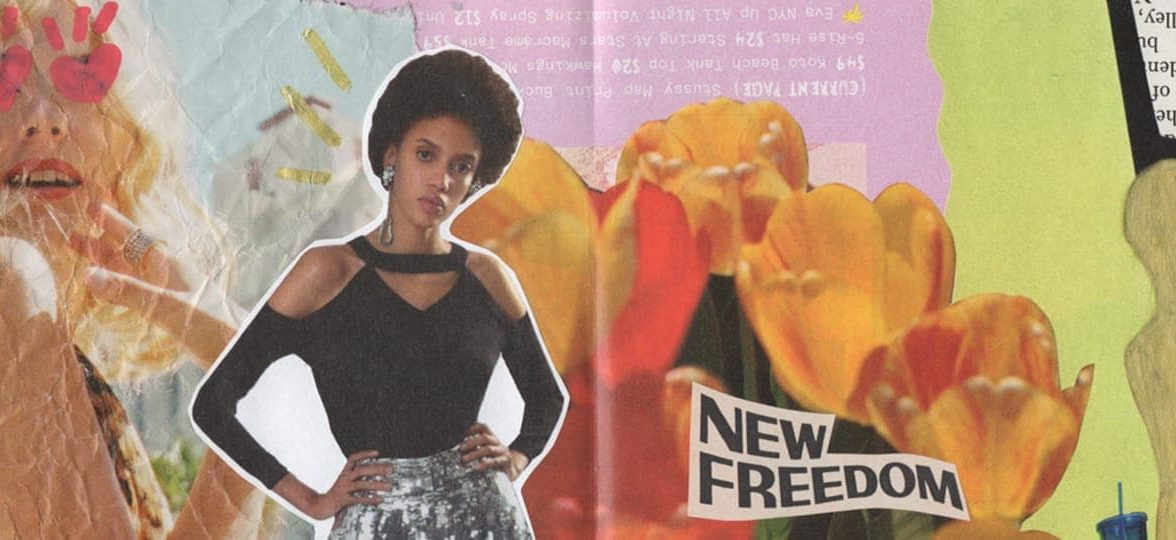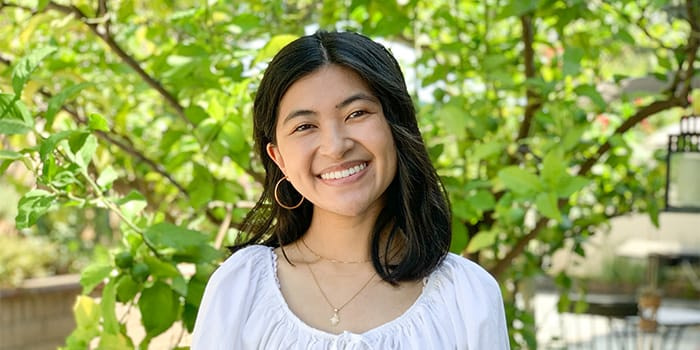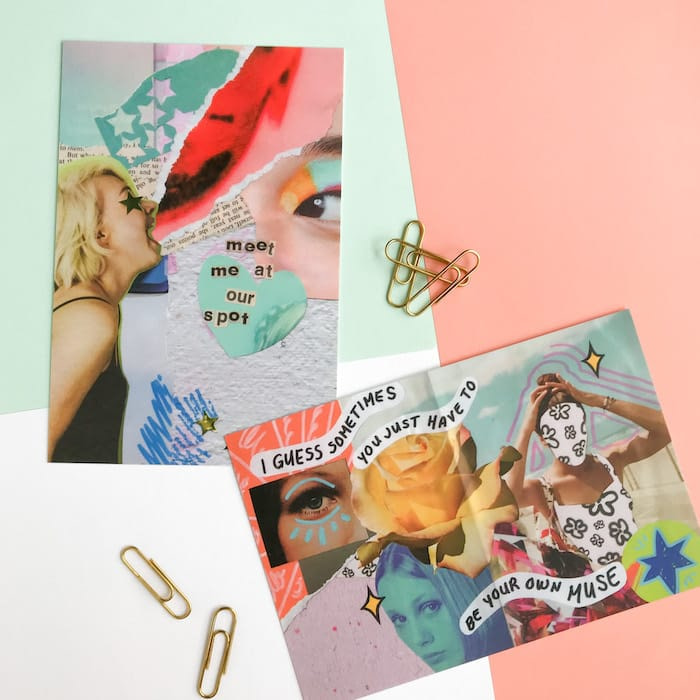Paper Puso: connecting the dots with collage
We met founder Mya Naguit to talk about her collage work and what led her to launch her own brand.

Mya Naguit is fresh out of college and she’s already wearing the hats of collage artist, activist, and founder of stationery brand Paper Puso. Collating together notes, illustrations, and magazine cutouts, the mixed media artist conjures intimate, authentic feelings through a visual melting pot.
We met Mya to talk about her collage work, the origins of Paper Puso, and the importance of connection in art and life.

Tell us a bit more about yourself and your background. What attracted you to collage and mixed media art?
Hi, my name is Mya! I’m a 22-year-old Filipino creative and collage artist from Orange, California. Ever since I was a little girl, I’ve always had this love for creating. I was terribly shy, and it was really hard for me to connect with others and truly express my feelings. Naturally, making art was my safe haven.
Making art was my safe haven
I don’t remember exactly what drew me to making collages specifically, but I do know that mixed media art was somewhat born out of my large collection of teen magazines, in addition to the journal entries I would write regularly. To this day, I still have a collection of journals and sketchbooks I’ve finished over the years. Almost my entire adolescence is mapped out through these books, using pens, markers, glue, and paper. It’s really cool to have a tangible record of each chapter in your life.

How would you describe your style? Where do you find inspiration?
Since so much of my relationship with mixed media collage was born out of my adolescence, there is this through-line of mixed emotions and nostalgia in my work. I’ve always loved art that marries the contrast between messy and complicated emotions with pretty, pastel colours. I think my art definitely represents that. I find a lot of inspiration through the physical papers I clip, late 1990s-early 2000’s pop culture, music, and the fashion magazines I obsessed over as a teenager.
How do you go about making a collage? What’s your favourite part of the process and what materials do you enjoy using the most?
The beauty of making collages is that you can really make them out of any resources you have readily available to you. On the most basic level, this usually consists of an adhesive, paper materials, and maybe a pair of scissors. Personally, I love to use Posca paint pens, glue sticks, and gold star stickers, which show up in my projects frequently.
For me, inspiration for a piece can come from any of my materials – whether it be a colour I’m drawn to at the moment, a song lyric I can’t get out of my head, or a clipping I’ve found out of a vintage magazine. My favourite part of the process is the physical act of cutting and ripping of the paper; it’s really therapeutic!
Mixed media artist, content creator, activist, storyteller… You wear many hats! How are all those connected?
Being an artist, content creator, activist, and storyteller are inherently intertwined and intersected parts of my identity. In saying this, I mean that I don’t think I could bear one label without bearing the other, and vice versa. For instance, being an activist often involves storytelling aspects of confronting an issue and forming relationships with a community that can open your eyes to perspectives you haven’t considered before.
This universal longing for connection […] is what drives us to create
In addition to that, creative work can be a sustainable and accessible way to tell and pass down a story. This is why we need to encourage and harness the skills and talents of our community members to put forth the change we wish to see in the world. I really do believe that this universal longing for connection, and with that, community, is what drives us to create. At least, that’s the reason why I began creating.
This idea of connection seems to be at the core of your work as an artist and activist. Can you tell us more about how you translate it in your visual work?
I think that any time you pour your heart into something, connection is inevitable; whether that be in a positive way or in a negative way. Making collages was something I used to do privately, which is what made the work so authentic and fearless.
When I started sharing my art online, I knew that I didn’t want to change that aspect of my process; there were obviously many personal places where I felt I had to set boundaries with public exposure, but I knew that whatever I did choose to share would always have to come straight from the heart. With that being said, I never shared my art with the specific intention of connecting with an audience… I was just being myself. And, as time passed, I noticed more and more of my audience relating to my vulnerability.
Did you face any challenges in your journey as a Filipina-American artist?
Being Filipino has shaped everything I’ve experienced throughout my entire life. I have never felt “challenged” in my journey as a product of my identity as a Filipina-American artist, specifically. If anything, “Filipino” is a label I’m proud to bear in any and all spaces that I can. I think the only challenge I face in relation to this is a pressure I put on myself to continue honouring the legacy my family and ancestors have shaped for me.
Can you tell us more about your brand, Paper Puso? What motivated you to start your own business while you were still at uni?
In my personal life, art-making has always been a sort of therapy for whatever I’m going through at the moment. Like most people in the midst of the 2020 lockdown, I found myself feeling more lost, yet more hungry to create than ever before. Of course, I was struggling with attending my junior year of university completely online; but the very physical chaos outside of my small bubble seemed to be producing the bulk of my anxiety.
I found myself feeling more lost, yet more hungry to create than ever before
One night, on a weekly pandemic Facetime call with three of my best friends, I brought up the idea of sharing my art online. I needed a space to archive my creative work, while doubling as a record of the art I was making (and the emotions I was feeling) during a global pandemic. Their simple words of encouragement were enough to push me to take the leap. And just like that, Paper Puso was born.
As a homage to my Filipino heritage, I chose to go under the name “Paper Puso” which translates to “Paper Heart”. It started with some pages scanned from my personal journal, and then some commissions from friends and family over the holidays. Now, over a year later, Paper Puso has garnered an entire community of support, has been featured in multiple digital and print platforms, and has produced hundreds of Postcard prints and Stickers that have shipped nationwide.
You mentioned that Paper Puso was inspired by your own love of letter-writing. What do you like most about it?
There’s something so romantic to me about physically writing your loved one a letter. I was born in 1999, so my generation grew up on the Internet; I actually don’t have a single memory of living without computer access. I think that harkening back to traditions like letter writing reminds us of the beauty of tangible artefacts; it’s one of the reasons I love journaling by hand. You’d be surprised how much one can express in a handwritten note that they’d never dare to speak out loud!
If you could be a pen pal with any historical figure or past artist, who would it be and why?
This is a great question, and one that I’ve had to think a lot about! I think it would be amazing to send the younger versions of my grandparents a handwritten note on the back of one of my Paper Puso postcards. I’m really curious to read first-hand accounts of how both sets of my grandparents handled their early 1920s in the Philippines.
How do you use MOO to promote your collage work?
I had heard about MOO from another artist in a vlog, and decided to try it out to print my first set of Postcards. I had originally planned to try MOO alongside other printing businesses to narrow down which service provided the most outstanding quality; but after ordering my first 25 Postcards from MOO, I was so satisfied with the products that I never got the chance to try out any other business!
Ever since that first “test run”, MOO has been my primary source for the bulk of my products. As an artist and a small business owner, I like to release new merchandise designs periodically, so I love that I can order in batches as small as 25 to phase out any old designs. The quality and customisation of my Postcards keep me coming back. I also think the MOO support team is incredibly helpful and responsive. Needless to say, I’m a huge fan of you, MOO!
Any projects coming up you’re looking forward to?
I’m going to be releasing a very exciting apparel collaboration with another small business for October, which is Filipino American History Month. There’s not much I can share about it as of yet, but my followers can keep a lookout for any news on my Instagram! I’m so excited.
Do you have any advice for young creatives looking to apply their skills to causes they care about?
I know that putting yourself out there and being vulnerable can be really scary. I think my generation has garnered so much fear surrounding failure, and that relentless insecurity is really difficult to navigate. So, above all things, I challenge young creatives to start small. Take a tiny step forward. Find resources that can help you inform your own experiences. Find what causes are affecting the communities you’re a part of. We each have something to offer. We all have the power to affect change, no matter how small… And the more tiny steps forward there are, the further we can go together!
Put yourself out there with MOO Postcards starting from 25 per pack.
Keep in touch
Get design inspiration, business tips and special offers straight to your inbox with our MOOsletter, out every two weeks.









